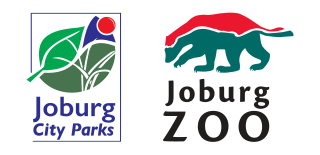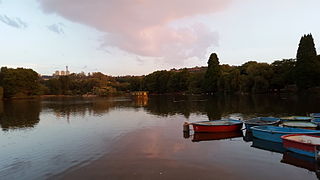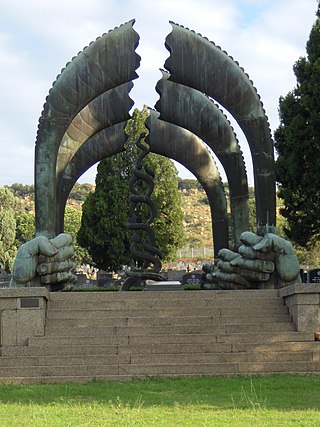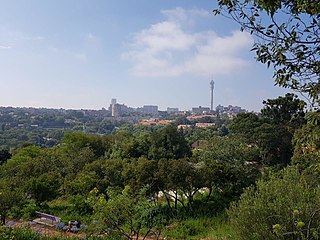
Melville is a bohemian suburb of Johannesburg, Gauteng, South Africa. It is the location of many restaurants and taverns, which are mostly frequented by students from the nearby University of Johannesburg, located in Auckland Park, and the University of the Witwatersrand, located in Braamfontein. It is one of the city's most popular tourist destinations. The suburb is to the west of the Johannesburg CBD. It is located in Region B of the City of Johannesburg Metropolitan Municipality.
Auckland Park is a suburb of Johannesburg, South Africa. It lies on a gentle slope, and is in close proximity to the suburbs of Melville, Brixton, Westdene and Richmond. Auckland Park is one of the few suburbs close to the Johannesburg city centre that has remained largely unaffected by the recent migration of Johannesburg residents to the city's northern suburbs. Auckland Park is home to a mix of nationalities and cultures, and the suburb is well known as the location of the South African Broadcasting Corporation headquarters.
Craighall is a suburb of Johannesburg, South Africa and is bordered by Hyde Park, Dunkeld and Parkhurst. It sits in between the busy arterial routes of Jan Smuts Avenue and Winnie Mandela Drive and is located in Region B of the City of Johannesburg Metropolitan Municipality.
Rivonia is a suburb of Johannesburg, South Africa in the Sandton area. It is located in Region E of the City of Johannesburg Metropolitan Municipality. Rivonia is one of the most affluent residential and business suburbs of Johannesburg, and regarded as the hub of upstart and established I.T. companies. The main retail thoroughfare in the area, Rivonia Boulevard, is the location of several shopping complexes as well as many other shops and restaurants. The area known as Rivonia includes the original township of Edenburg, Edenburg Extension 1, and 19 smaller extensions designated 'Rivonia Extension ...', numbered from 0 to 25. There is no designated township called Rivonia. The post code for Rivonia is 2128.

The Johannesburg Zoo or Joburg Zoo is a 55-hectare (140-acre) zoo in Johannesburg, South Africa. The zoo is dedicated to the accommodation, enrichment, husbandry, and medical care of wild animals, and houses about 2000 individuals of 320 species. Established in 1904, it has traditionally been owned and operated by the Johannesburg City Council. However, it has been turned into a corporation and registered as a Section 21 non-profit organisation.

The Jukskei River is one of the largest rivers in Johannesburg, South Africa. It is the southernmost river in the Crocodile River basin.
Braamfontein is a central suburb of Johannesburg, in South Africa, seat of the Constitutional Court of South Africa and some of South Africa's major corporations such as Liberty Holdings Limited, JD Group, Sappi, and Bidvest Bank and Hollard. Situated due north of the city centre, Braamfontein is the fourth-largest office node in the city of Johannesburg containing many multi-storied buildings representing various architectural styles including Art Deco and Brutalist. Numerous office buildings have and are in the process of being converted to residential apartments. The offices of the Johannesburg City Council and the University of the Witwatersrand are situated in Braamfontein. The Nelson Mandela Bridge is a landmark that connects Braamfontein to the city centre, traversing South Africa's most extensive passenger train marshalling yard. Jan Smuts Avenue and Empire Road are two major road thoroughfares that run through the suburb.
Parkhurst is a small, dense northern suburb of Johannesburg, Gauteng, of about 2000 households and 4000 residents. Forming part of the northern suburbs, Parkhurst is roughly bounded by Parktown North to the east, the Braamfontein Spruit to the west, Craighall to the north, and Greenside to the south.
Emmarentia is a suburb of Johannesburg, South Africa.
Greenside, is a suburb of Johannesburg, South Africa. Greenside borders on the suburbs Emmarentia, Parkview, Parkhurst and Victory Park.
Randpark Ridge is an upmarket suburb of Randburg, South Africa. It is located in Region B of the City of Johannesburg. It fell into the town of Randburg during the apartheid era. Developed in the early 1980s and still relatively new, Randpark Ridge is bordered by several other suburbs including Weltevreden Park, Sundowner, Boskruin, Bromhof, Honeydew and Fairland.

Johannesburg City Parks and Zoo (JCPZ) is a not-for-gain company established under Section 21 of the South African Companies Act and wholly owned by the City of Johannesburg.

Emmarentia Dam is a dam in Emmarentia, Johannesburg, South Africa. There are several dams that make up Emmarentia Dam, despite its allusion to the singular, with two small dams found upstream in the Johannesburg Botanical Gardens.

Zoo Lake is a popular lake and public park in Johannesburg, South Africa. It is part of the Hermann Eckstein Park and is opposite the Johannesburg Zoo. The Zoo Lake consists of two dams, an upper feeder dam, and a larger lower dam, both constructed in natural marshland watered by the Parktown Spruit.

The Braamfontein Spruit is the longest stream in Johannesburg, South Africa.

Westpark Cemetery is a large cemetery in Johannesburg, South Africa, and is the resting place of some of the country's well-known citizens. It is a non-denomination designated burial ground, and thus has Christian, Jewish, Muslim and Chinese burial areas. The Jewish section contains a Holocaust Memorial, erected in 1959.

The Wilds is an inner city park and nature reserve in the suburb of Houghton, in the city of Johannesburg, South Africa. The park consists of 16 hectares of indigenous vegetation on the sides of two rocky koppies or hills with views of the city of Johannesburg and its suburbs. Through the 1990s the park gained a reputation for being highly dangerous and crime ridden, however, it has since become "rejuvenated" due to the efforts of volunteers.

Westdene is a suburb of Johannesburg, South Africa. Westdene lies between the historic suburb of Sophiatown and Melville with the Melville Koppies nature reserve to the north of the suburb. Westdene derives its name from its location, literally meaning west-valley. 'West' since it is located west from the city centre and with 'dene' derived from the Old English denu, meaning valley.
Victory Park is a suburb of Johannesburg, South Africa, around 8 km northwest of City Hall.
The M20 is a short metropolitan route in the Greater Johannesburg metropolitan area, South Africa. It connects Randburg in the western part of Johannesburg with Edenvale in the east.














